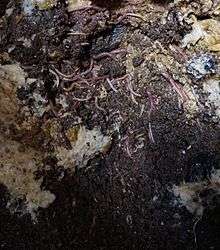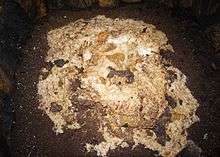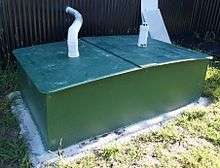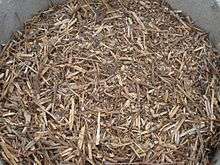Vermifilter

A vermifilter (also vermi-digester) is an aerobic treatment system, consisting of a biological reactor containing media that filters organic material from wastewater. The media also provides a habitat for aerobic bacteria and composting earthworms that produce humus. The "trickling action" of the wastewater through the media dissolves oxygen into the wastewater. This is an important feature because bacteria and worms that rapidly decompose organic substances need oxygen to survive. Wastewater is purified by removing pathogens and oxygen demand.
Vermifilters are most commonly used for sewage treatment and for agro-industrial wastewater treatment.[1] Treatment can take place in either large centralized systems or by smaller on-site sewage treatment. Vermifilters are also used if wastewater requires treatment before it can be safely discharged into the environment.
Vermifilters can be used for primary, secondary and tertiary treatment of blackwater and greywater. On-site systems can treat influent from flush toilets (vermifilter toilets). In this case, the treated effluent is disposed of to either surface or subsurface leach fields. Solid material (such as fecal matter and toilet paper) is retained, de-watered and digested by bacteria and earthworms. This converts material into humus. The liquid passes through filtration media to which microorganisms attach themselves and secondary treatment occurs. At that point, organic compounds naturally biodegrade. The oxygen dissolved in the water allows further degradation to take place.
Vermifilters are low cost aerobic wastewater treatment options. Because energy is not required for aeration, vermifilters can be considered "passive treatment" systems (pumps may be required if gravity flow is not possible). Another advantage is the high treatment efficiency given the low space requirement.
Terminology
A great number of terms are in use to describe vermifilters, including for example the words digester, composting, vermi-trickling filters or vermicomposting. Further alternative names for this process include aerobic biodigester or biological filter with earthworms.
When this kind of sanitation system is used to treat only the mixture of excreta and water from flush toilets or pour flush toilets (called blackwater) then the term "toilet" is added to the name of the process, such as "vermi-digester toilet" or "tiger (worm) toilet".
Overview
Vermifiltration was first advocated by researchers at the University of Chile in 1992 as a low cost sustainable technology suitable for decentralised sewage treatment in rural areas.[2] Vermifilters offer treatment performance similar to conventional decentralised wastewater treatment systems but with potentially higher hydraulic processing capacities.[2]
Vermifilters are a type of wastewater treatment biofilter or trickling filter but with the addition of earthworms to improve treatment efficiency.[3] Vermifilters provide an aerobic environment and wet substrate that facilitates microorganism growth as a biofilm. Microorganisms perform biochemical degradation of organic matter present in wastewater. Earthworms regulate microbial biomass and activity by directly or/and indirectly grazing on microorganisms.[4] Biofilm and organic matter consumed by composting earthworms is then digested into biologically inert castings (humus).[5] The vermicast is incorporated into the media substrate, slowly increasing its volume. As this builds up it can be removed and applied to soil as an amendment to improve soil fertility and structure.
Microorganisms present are heterotrophic and autotrophic. Heterotrophic microorganisms are important in oxidising carbon (decomposition) whereas autotrophic microorganisms are important in nitrification.
As a result of oxidation reactions, biodegradation and microbial stimulation by enzymatic action, organic matter decomposition and pathogen destruction occurs in the vermifilter. In a study where municipal wastewater was treated in a vermifilter, removal ratios for biochemical oxygen demand (BOD5) were 90%, chemical oxygen demand (COD) 85%, total suspended solids (TSS) 98%, ammonia nitrogen 75% and fecal coliforms eliminated to a level that meets World Health Organisation guidelines for safe re-use in crops.[6]
Process types
Vermifilters can be used for primary, secondary and tertiary treatment of blackwater and greywater.
Primary treatment of blackwater

Vermifilters can be used for aerobic primary treatment of domestic blackwater.[7] Untreated blackwater enters a ventilated enclosure above a bed of filter medium. Solids accumulate on the surface of the filter bed while liquid drains through the filter medium and is discharged from the reactor. The solids (feces and toilet paper) are aerobically digested by aerobic bacteria and composting earthworms into castings (humus), thereby significantly reducing the volume of organic material.

Primary treatment vermifilter reactors are designed to digest solid material, such as contained in raw sewage. Twin-chamber parallel reactors offer the advantage of resting one reactor while the other is active, to facilitate hygienic removal of humus with reduced pathogen levels.
Worms actively digest the solid organic material. An equilibrium is reached whereby volume digested by a stable population of worms matches the input volume of solid waste. Seasonal and environmental factors (such as temperature) and variable influent volumes can cause buildup of solid waste as a pile. Although oxygen is excluded from the centre of this "wet" compost pile, worms work from the outside in and introduce air as necessary into the pile to meet their nutritional requirements. This food resource buffer ensures primary treatment vermifilters have a level of resilience and reliability, provided space is provided for a pile to build up. There is some evidence that the wet environment facilitates digestion of solid waste by worms.[8] The volume of vermicast humus increases only slowly and occasionally needs to be removed from the primary treatment reactor.
Primary treatment of wet mixed blackwater can also include greywater containing food solids, grease and other biodegradable waste. Solid material is reduced to stable humus (wormcastings), with volume reductions of up to tenfold.[1]
The process produces primary treated blackwater, with much of the solid organic material removed from the effluent. Because liquid effluent is discharged almost immediately on entering the digester, little dissolved oxygen is consumed by the wastewater through the filtration stage. However, oxygen demand is leached into the wastewater flow through the filter as worms digest retained solids.[9] This oxygen demand can be removed with secondary treatment vermifilter reactors.[9] Primary treatment vermifilters provide a similar level of liquid effluent treatment to a septic tank,[10] but in less time because digestion of solids by worms takes place rapidly in the aerobic environment.[8]
The liquid effluent is either discharged directly to a drain field or undergoes secondary treatment before being used for surface irrigation of soil.
Secondary treatment

Secondary and tertiary treatment vermifilters can be underneath the primary vermifilter in a single tower but are typically single reactors, where several reactors can be chained in series as sequential vermifilters. Drainage within the reactor is provided by filter media packed according to the hydraulic conductivity and permeability of each material that is present within the vermifilter. The filter packing retains the solid particles present in the effluent wastewater, increases the hydraulic retention time and also provides a suitable habitat for sustaining a population of composting earthworms. This population requires adequate moisture levels within the filter media, but also adequate drainage and oxygen levels.
Sprinklers or drippers can be used in secondary and tertiary treatment vermifilter reactors (see image).
Hydraulic factors (hydraulic retention time, hydraulic loading rate and organic loading rate) and biological factors (earthworm numbers, levels of biofilm) can influence treatment efficiency.
Design
Vermifilters are enclosed reactors made from durable materials that eliminate vermin entry, usually plastic or concrete. Ventilation must be sufficient to ensure an aerobic environment for the worms and microorganisms, while also inhibiting entry of unwanted flies. Temperature within the reactor needs to be maintained within a range suitable for the species of compost worms used.[9]
Influent entry
Influent entry is from above the filter media. Full-flush toilets can have the entry point into the side of the reactor, whereas micro-flush toilets, because these do not provide sufficient water to convey solids through sewer pipes, are generally installed directly above the reactor. For primary treatment reactors, sufficient vertical space must be provided for growth of the pile. This is dependent on volume of solids in the influent and decomposition rate. Secondary and tertiary treatment reactors can use sprinklers or tricklers to distribute the influent wastewater evenly over the filter media to improve treatment efficiency of the filter media.
Sections
Vermifilter reactors may have three different filter sections: an organic filter as the top layer that provides habitat for the earthworms; the inorganic or inert filter - constituting a layer of gravel and a layer of sand; and the drainage layer or equalizer (a sump where the treated effluent is discharged and/or recirculated to the top of the reactor). The filter media may be suspended above a sump in a basket. Alternatively the filter media might sit on a drainage layer of coarse gravel or pervious plastic drainage coil. Synthetic geotextile cloth is used to retain the filter media in place above the drainage layer. To remain aerobic, adequate ventilation must be provided, along with an outlet for the liquid effluent to drain away.
Filter substrate
Drainage within the vermifilter reactor is provided by the filter media. The filter media has the dual purpose of retaining the solid organic material while also providing a habitat suitable for sustaining a population of composting worms. This population requires adequate moisture levels within the media, along with good drainage and aerobic conditions.
Common filter packing materials include sawdust,[11][12] wood chips, coir, bark, peat, and straw for organic packing. Gravel, quartz sand, river bed gravel, pumice, mud balls, glass balls, ceramsite and charcoal are commonly used for inert packing. Surface area and porosity of filter packing materials influence treatment performance.[13] Thus materials with low granulometry and large surface area may improve the performance of the vermifilter.
Sizing
Vermifilters can be constructed as single tower systems, or separate staged reactors (either gravity or pump operated) for the treatment of wastewater according to design requirements (primary, secondary, tertiary treatment). More stages [14][15] can increase level of treatment because multiple stage systems provide accumulating aerobic conditions suitable for nitrification of ammonium and removal of COD.
The design parameters of vermifilters include stocking density of earthworms[16] (although over time earthworm population tends to be self-moderating), filter media composition,[17] hydraulic loading rate,[18] hydraulic retention time[12][19] and organic loading rate. Hydraulic retention time and hydraulic loading rate both affect treatment and effluent quality. Hydraulic retention time is the actual time the wastewater is in contact with the filter media and is related to the depth of the vermifilter (which may increase over time due to the accumulation of earthworm vermicastings), reactor volume and type of material used (porosity). The hydraulic retention time determines wastewater inflow rate (hydraulic loading as influent volume per hour).
In principle, provided the environment is aerobic, the longer the wastewater remains inside the filter, the greater the BOD5 and COD removal efficiency will be, but at the expense of hydraulic loading. Wastewater requires sufficient contact time with the biofilm to allow for the adsorption, transformation, and reduction of contaminants.[20] Hydraulic loading rate is an essential design parameter and equates to the volume and of wastewater that a vermifilter can reasonably treat in a given time. For a given system, higher hydraulic loading rates will cause hydraulic retention time to decrease and therefore reduce level of treatment. Hydraulic loading rate may depend on parameters such as structure, effluent quality and bulk density of filter packing, along with method of effluent application.[21] Common Hydraulic retention time values in vermifiltration systems range from 1 to 3 hours.[22] Hydraulic loading rates commonly vary between 0.2 m3 m−2 day−1,[23] 3.0 m3 m−2 day−1 [24] or 10-20 g L−1.[25] Organic loading rate is defined as the application of soluble and particulate organic matter (as BOD5) per unit area per unit time.[21][26]
Treatment efficiency is influenced by health, maturity and population abundance of earthworms. Abundance is a fundamental parameter for efficient operation of a vermifiltration system.[27] Different values are reported in literature usually in grams or number of individuals per volume of filter packing or surface area of filter packing. Common densities vary between 10 g L−1 and 40 g L−1 per filter packing material.[28][29]
An abundance of earthworms improves treatment efficiency, in particular BOD5, TSS and NH4+ removal. This is because earthworms release organic matter into the filter media and stimulate nitrogen mineralization. Earthworm castings may have substances which contribute to higher BOD5 removal.[30]
Operation and maintenance


A vermifilter has low mechanical and manual maintenance requirements, and, where gravity operated, requires no energy input. Recirculation, if required for improved effluent quality, would require a pump.
An annual application of dry organic materials on the top of the filter media may be required for secondary and tertiary treatment vermifilters. The volume of vermicast increases only slowly and occasionally vermicompost needs to be removed from the vermifilter.
Solids accumulate on the surface of the organic filter media (or filter packing). The liquid fraction drains through the medium into the sump or equaliser and is either discharged from the reactor or recirculated to the top entry for further treatment. Wastewater is discharged to the surface of the filter packing by direct application or by sprinklers, drippers or tricklers.
Examples
- A household pour flush toilet combined with primary vermifiltration and direct effluent soakage to soil, called the "Tiger Toilet", has been tested by Bear Valley Ventures and Primove Infrastructure Development Consultants in rural India. Unlike in a pit latrine, it was found that there was virtually no accumulation of fecal material over a one-year period. In the effluent there was a 99% reduction in fecal coliforms. User satisfaction was high, driven mainly by a lack of odour.[8][31] This system is now being marketed commercially in India where over 2000 of these toilets and treatment systems had been sold and installed by May 2017.[32]
- "Tiger worm toilets" are also being promoted by Oxfam as a sanitation solution in refugee camps, slums and peri-urban areas in Africa, for example in Liberia.[33]
- Low-flush vermifilter toilet systems with direct subsoil soakage are being marketed in Ghana and other African countries by the Ghana Sustainable Aid Project (GSAP) with support by Providence College in the U.S. and the University of Ghana.
- Biofilcom is a company active in Ghana which is marketing the process under the name of "Biofil Digester".
- In Australia and New Zealand, there are numerous suppliers offering vermifilter systems for domestic greywater and/or blackwater treatment, with primary treated effluent disposal to subsurface leach fields. Examples include Wormfarm, Zenplumb, Naturalflow, SWWSNZ and Autoflow.
See also
References
- 1 2 C. Furlong, M.R. Templeton, W.T. Gibson. Processing of human faeces by wet vermifiltration for improved on-site sanitation, Journal of Water, Sanitation and Hygiene for Development 4(2):231, June 2014
- 1 2 Meiyan Xing, Xiaowei Li and Jian Yang. Treatment performance of small-scale vermifilter for domestic wastewater and its relationship to earthworm growth, reproduction and enzymatic activity, African Journal of Biotechnology, November 2010
- ↑ Manyuchi, M.M., Kadzungura, L., Boka, S. Vermifiltration of Sewage Wastewater for Potential Use in Irrigation Purposes Using Eisenia fetida Earthworms World Academy of Science, Engineering and Technology 78 2013, 538–542.
- ↑ Jiang, L., Liu, Y., Hu, X., Zeng, G., Wang, H., Zhou, L., Tan, X., Huang, B., Liu, S., Liu, S., 2016. The use of microbial-earthworm ecofilters for wastewater treatment with special attention to influencing factors in performance: A review. Bioresour. Technol. 200, 999–1007
- ↑ Liu, J., Lu, Z., Yang, J., Xing, M., Yu, F., Guo, M., 2012. Effect of earthworms on the performance and microbial communities of excess sludge treatment process in vermifilter. Bioresour. Technol. 117, 214–21
- ↑ Lourenço, N.; Nunes, L.M. "Optimization of a vermifiltration process for treating urban wastewater". Ecological Engineering. 100: 138–146. doi:10.1016/j.ecoleng.2016.11.074.
- ↑ Rajiv K. Sinha, Gokul Bharambe, Uday Chaudhari. Sewage treatment by vermifiltration with synchronous treatment of sludge by earthworms: a low-cost sustainable technology over conventional systems with potential for decentralization, Environmentalist, 2008 28:409-420
- 1 2 3 C. Furlong, W. T. Gibson, M. R. Templeton, M. Taillade, F. Kassam, G. Crabb, R. Goodsell, J. McQuilkin, A. Oak, G. Thakar, M. Kodgire, R. Patankar. The development of an onsite sanitation system based on vermifiltration: the "Tiger Toilet", Journal of Water, Sanitation and Hygiene for Development, January 2015
- 1 2 3 Taylor, M. Clarke, W. P., Greenfield, P. F. The treatment of domestic wastewater using small-scale vermicompost filter beds, Journal of Ecological Engineering, December 2003 21: 197–203
- ↑ A.S. Molla , P. O. Antwi , R.A. Buamah , H.M. Essandoh , E. Awuah The Potential of Subsurface Infiltration for the Treatment of Biofil Toilet Technology Effluent, Management Studies, December 2015
- ↑ Arora, S., Rajpal, A., Kumar, T., Bhargava, R., Kazmi, A.A., 2014. Pathogen removal during wastewater treatment by vermifiltration. Environ. Technol. 35, 2493–2499.
- 1 2 Arora, S., Rajpal, A., Kazmi, A.A., 2016. Antimicrobial Activity of Bacterial Community for Removal of Pathogens during Vermifiltration. J. Environ. Eng. 142 (5).
- ↑ Dahab, M.F. 1982 Effect of media design on the performance of fixed-bed anaerobic filters. Water Science & Technology, 15, 369–383.
- ↑ Wang, L., Guo, F., Zheng, Z., Luo, X. & Zhang, J. 2011 Enhancement of rural domestic sewage treatment performance, and assessment of microbial community diversity and structure using tower vermifiltration. Bioresource Technology, 102, 9462–70.
- ↑ Tomar, P., Suthar, S. 2011 Urban wastewater treatment using vermi-biofiltration system. Desalination, 282, 95–103.
- ↑ Sinha, R.K., Bharambe, G., Chaudhari, U., 2008. Sewage treatment by vermifiltration with synchronous treatment of sludge by earthworms: a low-cost sustainable technology over conventional systems with potential for decentralization. Environmentalist, 28(4), 409–420.
- ↑ Cardoso-Vigueros, L., Ramírez-Camperos, E., Garzón-Zúñiga, M., 2013. Evaluation of a pilot vermifilter for the treatment of wastewater. Ingeniería Agrícola y Biosistemas, 5(2), 33–44.
- ↑ Kumar, T., Bhargava, R., Prasad, K.S.H., Pruthi, V., 2015. Evaluation of vermifiltration process using natural ingredients for effective wastewater treatment. Ecol. Eng. 75, 370–377.
- ↑ Arora, S., Rajpal, A., Kumar, T., Bhargava, R., Kazmi, A.A., 2014. A comparative study for pathogen removal using different filter media during vermifiltration. Water Sci. Technol. 70, 996–1003.
- ↑ Hughes, R.J., Nair, J., Ho, G., 2008. The toxicity of ammonia/ammonium to the vermifiltration wastewater treatment process. Water Sci. Technol. 58, 1215–20.
- 1 2 Siegrist, R.L., 1987. Soil Clogging During Subsurface Wastewater Infiltration as Affected by Effluent Composition and Loading Rate. J. Environ. Qual. 16(2): 181-187.
- ↑ Sinha, R.K., Bharambe, G., Chaudhari, U., 2008. Sewage treatment by vermifiltration with synchronous treatment of sludge by earthworms: a low-cost sustainable technology over conventional systems with potential for decentralization. Environmentalist 28, 409–420.
- ↑ Li, Y.S., Xiao, Y.Q., Qiu, J.P., Dai, Y.Q., Robin, P., 2009. Continuous village sewage treatment by vermifiltration and activated sludge process. Water Sci. Technol. 60(11), 3001–10.
- ↑ Manyuchi, M.M., Kadzungura, L., Boka, S., 2013. Vermifiltration of Sewage Wastewater for Potential Use in Irrigation Purposes Using Eisenia fetida Earthworms, 538–542.
- ↑ Lourenço, N., Nunes, L.M. (2017) Optimization of a vermifiltration process for treating urban wastewater. Volume 100, March 2017, Pages 138–146
- ↑ Otis, R.J., 2001. Boundary Design: A Strategy for Subsurface Wastewater Infiltration System Design and Rehabilitation. On-Site Wastewater Treatment Procedures: Proceedings of the Ninth National Symposium on Individual and Small Community Sewage Systems. ASAE. St. Joseph MI. p 245-260.
- ↑ Li, Y.S., Robin, P., Cluzeau, D., Bouché, M., Qiu, J.P., Laplanche, A., Hassouna, M., Morand, P., Dappelo, C., Callarec, J., 2008. Vermifiltration as a stage in reuse of swine wastewater: Monitoring methodology on an experimental farm. Ecol. Eng. 32, 301–309.
- ↑ Tomar, P., Suthar, S., 2011. Urban wastewater treatment using vermi-biofiltration system. Desalination 282, 95–103.
- ↑ Zhao, L., Wang, Y., Yang, J., Xing, M., Li, X., Yi, D., Deng, D., 2010. Earthworm-microorganism interactions: a strategy to stabilize domestic wastewater sludge. Water Res. 44(8), 2572–82.
- ↑ Lourenço, N., Nunes, L.M., Submitted. Optimization of a vermifiltration process for treating urban wastewater. Ecological Engineering.
- ↑ Furlong, C.; Gibson, W.T.; Oak, A.; Thakar, G.; Kodgire, M.; Patankar, R. (April 2016). "Technical and user evaluation of a novel worm-based, on-site sanitation system in rural India". Waterlines. 35 (2): 148–162. doi:10.3362/1756-3488.2016.013. Retrieved 16 May 2017.
- ↑ "Tiger Toilet - A Breakthrough Sanitation Solution". Tiger Toilet. Retrieved 16 May 2017.
- ↑ Watako, David; Mougabe, Koslengar; Heath, Thomas (April 2016). "Tiger worm toilets: lessons learned from constructing household vermicomposting toilets in Liberia". Waterlines. 35 (2): 136–147. doi:10.3362/1756-3488.2016.012. Retrieved 16 May 2017.